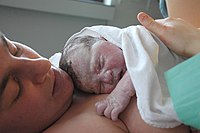
Photo from wikipedia
OBJECTIVE To evaluate the association between opioid prescribing during pregnancy and new persistent opioid use in the year following delivery. STUDY DESIGN This nationwide retrospective cohort study included patients ages… Click to show full abstract
OBJECTIVE To evaluate the association between opioid prescribing during pregnancy and new persistent opioid use in the year following delivery. STUDY DESIGN This nationwide retrospective cohort study included patients ages 12-55 in Optum's de-identified Clinformatics® Data Mart Database, undergoing vaginal birth (VB) or cesarean birth (CB) from 2008-2016, with continuous enrollment from 2-years before birth to 1-year post- discharge. Women were included if they were opioid-naïve in pregnancy (i.e. did not fill an opioid prescription 2-years to 9-months before delivery) and did not undergo a procedure within the year after discharge. The exposure was filling an opioid prescription in pregnancy. The primary outcome was new persistent opioid use (NPOU), defined as a pharmacy claim for ≥1 opioid prescription between 4-90 days post-discharge and ≥1 prescription between 91-365 days post-discharge. Clinical and demographic covariates were included. Analyses included descriptive statistics and multivariable logistic regression, adjusting for clinical and demographic covariates. RESULTS Of 158,425 childbirths identified, 101,013 (63.8%) were VB and 57,412 (36.2%) were CB. Among all patients, 6.0% (9,429) filled an opioid prescription during pregnancy. The factors associated with filling an opioid in pregnancy were having a non-delivery procedure in pregnancy [adjusted OR (aOR) 9.60, 95% CI (8.81-10.47)] and having an emergency room visit during pregnancy [aOR 2.48, 95% CI (2.37-2.59)]. Of women who received an opioid in pregnancy, 4% (379) developed NPOU. The factors most associated with NPOU were receiving an opioid prescription during pregnancy [aOR 3.45 95% CI (3.04-3.92)] and filling a peripartum opioid prescription (1-week prior to 3-days post-discharge) [aOR 2.28, 95% CI (2.02-2.57)]. Though having a procedure during pregnancy was associated with increased receipt of an opioid prescription, it was also associated with reduced NPOU [aOR 0.72, 95% CI 0.52-0.99)]. CONCLUSION Women who receive an opioid prescription during pregnancy are more likely to experience new persistent opioid use. Maternity care providers must balance pain management in pregnancy with potential risks of opioids.
Journal Title: American journal of obstetrics and gynecology
Year Published: 2020
Link to full text (if available)
Share on Social Media: Sign Up to like & get
recommendations!